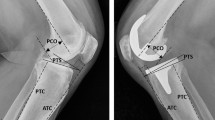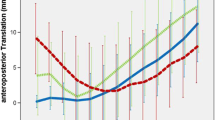Abstract
Purpose
Pre- and postoperative tibial posterior slope angles (PSAs) were assessed in patients who underwent cruciate-retaining total knee arthroplasty (TKA).
Material and methods
A total of 386 cruciate retaining TKA were performed in 308 patients and retrospectively reviewed. Based on the prostheses, 202 cases using NexGen® were classified as group I, 120 cases using PFC sigma® as group II, and 64 cases using Vanguard® as group III. Postoperative PSA of groups I, II, and III were compared.
Results
In groups I, II, and III, postoperative PSA was 6.0˚, 6.0˚, and 4.5˚, respectively (p < 0.001). Between preoperative measurement and final follow-up examination, mean knee score (59.7 to 97.3), function score (54.2 to 90.5), and range of motion (ROM; 126.7° to 132.2°) improved. These three values did not differ significantly among groups.
Conclusions
The 3° slope of the Vanguard® polyethylene insert caused the difference in PSAs. This design characteristic should be considered when using this implant in TKA.


Similar content being viewed by others
References
Bai B, Baez J, Testa N, Kummer FJ (2000) Effect of posterior cut angle on tibial component loading. J Arthroplasty 15:916–920
Bellemans J, Robijns F, Duerinckx J, Banks S, Vandenneucker H (2005) The influence of tibial slope on maximal flexion after total knee arthroplasty. Knee Surg Sports Traumatol Arthrosc 13:193–196
Brazier J, Migaud H, Gougeon F, Cotten A, Fontaine C, Duquennoy A (1996) Evaluation of methods for radiographic measurement of the tibial slope. A study of 83 healthy knees. Rev Chir Orthop Reparatrice Appar Mot 82:195–200
Buechel FF, Pappas MJ (1989) New Jersey low contact stress knee replacement system. Ten-year evaluation of meniscal bearings. Orthop Clin North Am 20:147–177
Catani F, Fantozzi S, Ensini A, Leardini A, Moschella D, Giannini S (2006) Influence of tibial component posterior slope on in vivo knee kinematics in fixed-bearing total knee arthroplasty. J Orthop Res 24:581–587
Chiu KY, Zhang SD, Zhang GH (2000) Posterior slope of tibial plateau in Chinese. J Arthroplasty 15:224–227
Choi CH, Kim JH, Chung HK, Choi YH (2001) Measurement of posterior slope angle of the proximal tibia by MRI and X-ray. J Korean Orthop Assoc 36:569–573
Dejour H, Bonnin M (1994) Tibial translation after anterior cruciate ligament rupture. Two radiological tests compared. J Bone Joint Surg Br 76:745–749
Dixon MC, Brown RR, Parsch D, Scott RD (2005) Modular fixed-bearing total knee arthroplasty with retention of the posterior cruciate ligament. A study of patients followed for a minimum of fifteen years. J Bone Joint Surg Am 87:598–603
Dorr LD, Boiardo RA (1986) Technical considerations in total knee arthroplasty. Clin Orthop Relat Res 205:5–11
Giffin JR, Vogrin TM, Zantop T, Woo SL, Harner CD (2004) Effects of increasing tibial slope on the biomechanics of the knee. Am J Sports Med 32:376–382
Higuchi H, Hatayama K, Shimizu M, Kobayashi A, Kobayashi T, Takagishi K (2009) Relationship between joint gap difference and range of motion in total knee arthroplasty: a prospective randomised study between different platforms. Int Orthop 33:997–1000
Hofmann AA, Bachus KN, Wyatt RW (1991) Effect of the tibial cut on subsidence following total knee arthroplasty. Clin Orthop Relat Res 269:63–69
Insall JN, Dorr LD, Scott RD, Scott WN (1989) Rationale of the Knee Society clinical rating system. Clin Orthop Relat Res 248:13–14
Jenny JY, Rapp E, Kehr P (1997) Proximal tibial meniscal slope: a comparison with the bone slope. Rev Chir Orthop Reparatrice Appar Mot 84:435–438
Jiang CC, Yip KM, Liu TK (1994) Posterior slope angle of the medial tibial plateau. J Formos Med Assoc 93:509–512
Jojima H, Whiteside LA, Ogata K (2004) Effect of tibial slope or posterior cruciate ligament release on knee kinematics. Clin Orthop Relat Res 426:194–198
Kuwano T, Urabe K, Miura H, Nagamine R, Matsuda S, Satomura M, Sasaki T, Sakai S, Honda H, Iwamoto Y (2005) Importance of the lateral anatomic tibial slope as a guide to the tibial cut in total knee arthroplasty in Japanese patients. J Orthop Sci 10:42–47
Laskin RS, Rieger MA (1989) The surgical technique for performing a total knee replacement arthroplasty. Orthop Clin North Am 20:31–48
Massin P, Gournay A (2006) Optimization of the posterior condylar offset, tibial slope, and condylar roll-back in total knee arthroplasty. J Arthroplasty 21:889–896
Matsuda S, Miura H, Nagamine R, Urabe K, Ikenoue T, Okazaki K, Iwamoto Y (1999) Posterior tibial slope in the normal and varus knee. Am J Knee Surg 12:165–168
Piazza SJ, Delp SL, Stulberg SD, Stern SH (1998) Posterior tilting of the tibial component decreases femoral rollback in posterior-substituting knee replacement: a computer simulation study. J Orthop Res 16:264–270
Schnurr C, Csécsei G, Nessler J, Eysel P, König DP (2011) How much tibial resection is required in total knee arthroplasty? Int Orthop 35:989–994
Seon JK, Park JK, Jeong MS, Jung WB, Park KS, Yoon TR, Song EK (2011) Correlation between preoperative and postoperative knee kinematics in total knee arthroplasty using cruciate retaining designs. Int Orthop 35:515–520
Tsuji S, Tomita T, Hashimoto H, Fujii M, Yoshikawa H, Sugamoto K (2011) Effect of posterior design changes on postoperative flexion angle in cruciate retaining mobile-bearing total knee arthroplasty. Int Orthop 35:689–695
Walker PS, Garg A (1991) Range of motion in total knee arthroplasty. A computer analysis. Clin Orthop Relat Res 262:227–235
Wasielewski RC, Galante JO, Leighty RM, Natarajan RN, Rosenberg AG (1994) Wear patterns on retrieved polyethylene tibial inserts and their relationship to technical considerations during total knee arthroplasty. Clin Orthop Relat Res 299:31–43
Whiteside LA, Amador DD (1988) The effect of posterior tibial slope on knee stability after Ortholoc total knee arthroplasty. J Arthroplasty 3(Suppl):S51–S57
Author information
Authors and Affiliations
Corresponding author
Rights and permissions
About this article
Cite this article
Bae, D.K., Song, S.J., Yoon, K.H. et al. Comparative study of tibial posterior slope angle following cruciate-retaining total knee arthroplasty using one of three implants. International Orthopaedics (SICOT) 36, 755–760 (2012). https://doi.org/10.1007/s00264-011-1395-3
Received:
Accepted:
Published:
Issue Date:
DOI: https://doi.org/10.1007/s00264-011-1395-3




